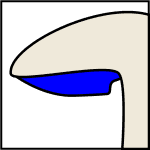Sulphur knight / Spring / Summer / Autumn / Toxic
Common Names
Sulphur knight, Gas works mushroom, Stinker, Gas agaric
Scientific Name
Tricholoma sulphureum
Family
Tricholomataceae
Commonly known as the Knights
Click here to learn more about the Knight family.
Habitat
Ectomycorrhizal with deciduous broadleaf trees, mainly oaks and Beech and occasionally found also in coniferous woodland. Fruits from spring to autumn. Occasional in the British Isles but less frequent in Scotland.
Description
Tricholoma sulphureum is a medium sized mushroom with a distinct yellow-green coloration and unmistakable smell.
Identifying Features:
Cap:
3–8 cm in diameter. Initially convex, then flattening sometimes with a central depression and vague umbo. Bright yellow with brown/ purple tinges
Stem:
3–10cm tall, Cylindrical and slender about 1-1.5 cm wide sometimes with a curve. Yellow with fine red-brown fibres, with no skirt.
Flesh:
Yellow, not fragile
Gills:
Yellow gills, distant and adnate to emarginate
Smell:
Often described as strong and unpleasant, with a smell of sulphur, coal gas, an ashtray or fresh feces.
Spores:
White
Uses:
In Food
Although it is not known to be deadly, Tricholoma sulphureum can cause nausea, vomiting, or gastrointestinal issues if consumed so is considered toxic and should not be eaten. Weirdly despite its awful smell it apparently doesn’t taste of much.
Medicinal Uses
There are no known medicinal uses
Known Hazards
Although it is not known to be deadly, Tricholoma sulphureum can cause nausea, vomiting, or gastrointestinal issues if consumed so is considered toxic and should not be eaten.
Potential Lookalikes
Yellow knight (Tricholoma flavovirens/Tricholoma equestre)– similar with a stronger yellow colour but lacks odour.
Some of the Rust gill fungi, which are equally non edible, have similar tones and appearance but have a rusty coloured spore print.
Resources
https://www.first-nature.com/fungi/tricholoma-sulphureum.php
Edible mushrooms by Geoff Dann










